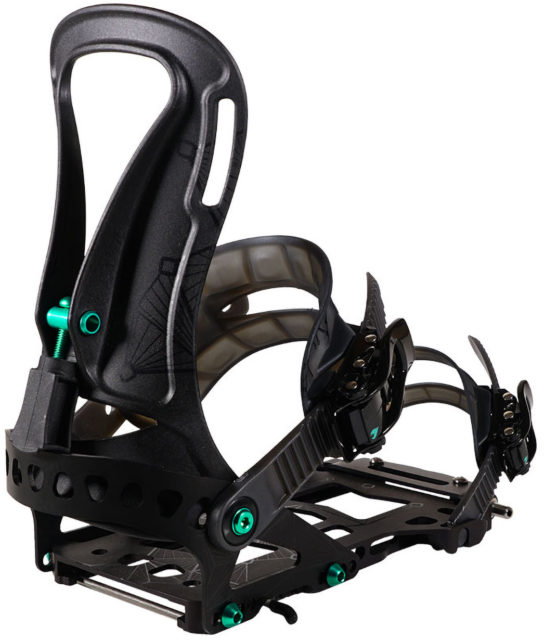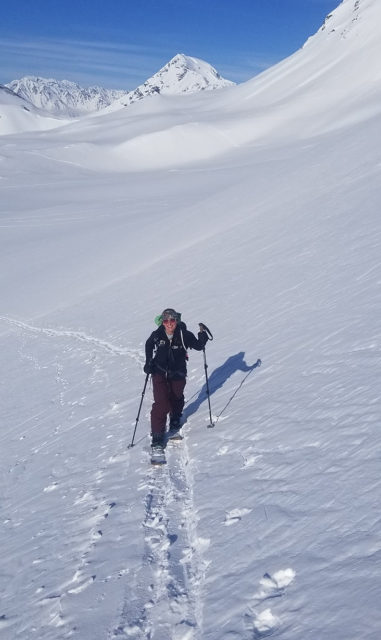2020-2021 Spark R&D Women’s Arc Pro
Test Locations: Valdez, Hatcher Pass, Turnagain Pass, & Alyeska Resort, AK
Days Tested: 20
Size Tested: Medium/Large
Stated Weight: 544 grams per binding
Stated Features:
- Pillow Line Straps-Light Pebax plastic for increased durability in cold temperatures, with malleable strap pillows to conform to your boot.
- Carbon Reinforced Highbacks: “Rip N’ Flip” highback made of carbon reinforced nylon with a tool-free Forward Lean Adjuster.
- Whammy Bar Climbing Wire: A heel riser built into the base of your binding with an easy access adjustment lever. Provides heel rise of 12 and 18 degrees.
- Pro Hardware: Custom made 7075 T6 aluminum for extra weight savings. 65% lighter than stainless steel components. Hex key head.
- Puck Compatibility: May be used with all Spark and Voile mounting pucks.
- T1 System: Slide and clip toe piece for tour mode. No pin for easier transitions.
MSRP: $540
Boards Used: Prior Brandywine XTC Split, Venture Tempest Split
Boots Used: Burton Mint, Burton Supreme
[Note: Our review was conducted on the 19/20 Arc Pro, which returns unchanged for 20/21.]

Intro
If you’re a frequent reader of Blister, you’ll know that many of us are fans of Spark R&D’s splitboard bindings. Based in Bozeman, Montana, Spark R&D has been at the forefront of splitboard binding technology since their debut in 2006. Spark has continued the cycle of research and design throughout the years, resulting in a line of simple, practical, and reliable backcountry bindings.
Recently, Spark debuted a line of stellar women’s-specific bindings, taking all their reliable designs and modifying them for the narrower feet and shorter calves of women. What’s really cool is that these women’s-specific models aren’t limited just to the standard versions — they also include the high-end, ultralight “Pro” versions of Spark’s bindings.
This past fall I posted a review of the women’s Surge Pro binding and came away really impressed. The Surge is the stiffer binding in the Spark lineup, but I’ve also been using the softer and lighter alternative, the women’s Arc Pro. So, how does it compare, and why should you pick one over the other?
Design / Construction
After previously testing the Women’s Surge Pro, I did not think Spark could produce a lighter binding. I was wrong, as the Arc Pro manages to be noticeably lighter while retaining many of the same components as the Surge. There are some notable design differences that allow the Arc Pro to be slightly more flexible, forgiving, and lighter, with a design that focuses more on a playful ride than razor-sharp precision and maximum power transfer.
The Women’s Arc Pro comes with Spark’s custom Pillow Line Straps. Molded of Pbex plastic, they are designed to resist cold-induced weakening while providing the most comfortable fit possible. The straps are reportedly designed using data from 3D scans of popular snowboarding boots, and it seems the technique was a success. The Arc Pro ankle straps differ slightly from that of the Surge Pro, as the Arc Pro strap is slightly narrower with a small “flex window” in the middle to allow for more compliance. The toe strap is the same for both models.
All of Spark’s “Pro” series bindings come with Rip ‘N’ Flip carbon-reinforced nylon highbacks, as opposed to fiberglass on the standard models. In addition to weight reduction, carbon fiber gives the highback the benefit of added strength, stiffness, and responsiveness. The Arc Pro’s highbacks are designed for a “medium” flex rating (a bit more flexible than the Surge Pro) to enable a more fluid, surfy ride. Though the Rip ‘N’ Flip highback has no padding, it’s supported my lower leg wonderfully with a comfortable fit. The highback comes equipped with a user-friendly forward-lean adjuster, providing support for 0-22° of forward lean. For the uphill, the adjuster also allows for a -13° touring position.

Standard with all current Spark R&D bindings is the Whammy Bar Climbing Wire. Spark has reinvented their old heel riser concept by replacing double-wires with one multi-stage climbing wire. I really enjoyed using this new design, as it eliminates the much-dreaded task of fumbling between wires with gloved hands. The Whammy Bar Climbing Wire comes with a small handle to provide quick and easy access with zero fumble-factor.
The heel loops of the Arc Pro (and all other Pro-series bindings) are constructed of 7075 aluminum for weight savings. 7075 allows for the loops to be constructed of thinner material without compromising strength. As with all of Spark’s women’s-specific bindings, the heel loops of the Arc Pro are lower and more compact to provide proper fit and placement of the ankle strap and highback. Each loop has 4 stages of adjustment on the baseplate, allowing the bindings to comfortably fit a range of boot sizes.
One of the major contributors to the weight reduction on the Arc Pro is the honey-combed baseplate. Spark refers to this as “Maximum baseplate cutout,” meaning they have removed as much of the baseplate as possible without compromising structural stability and performance. A nice byproduct of this feature is the ability to adjust the pucks on your snowboard without using a template, something I have greatly appreciated for its simplicity. The missing material also likely plays a role in making the binding more flexible, adding to the more playful feel of the bindings.

As with every binding in the current Spark lineup, the Arc Pro comes equipped with Spark’s Tesla T1 touring system. The T1 system was designed as a more functional replacement for original toe-pin systems for splitboard bindings (still used in Voile Light Rail bindings if you are unfamiliar). The T1 system’s toe piece lets you slide pins in from the side and then are locked into place with what Spark calls a “snap ramp.” I’ve found this system super easy to use and it provides a smooth pivot point from the two lightweight pins. To swap over to ride mode, you simply release the toe piece, slide the bindings onto your pucks, then snap the toe piece back down to lock in place. The system is extremely user friendly, resistant to ice buildup, and provides a play-free fit. It is compatible with all Voile and Spark pucks.
Uphill Performance
I cannot commend Spark enough for producing such an energy-efficient binding. At a stated weight of 544 grams per binding, the Arc Pro takes weight reduction a step beyond that of the Surge Pro, positioning it as the lightest women’s splitboard binding on the market (compared to Karakoram Prime-X-W at 570 g and Voile W Light Rail at 680 g). More importantly, the weight savings are a product of intelligent engineering and materials choice, allowing the binding to be ultralight without reducing structural integrity or function. I found myself really enjoying the journey through mountains as I challenged myself to keep up with marathon-running friends, who classically have no sympathy for my non-marathon-running lungs.
On flats and mellow inclines, Arc Pro is wonderful. The T1 system provides a smooth pivot at the toe with zero resistance or slop. Lifting the forward lean adjuster creates open space between your calf and the highback to increase comfort and allow a natural stride while touring. The free space also allows you to lean back and weight your heels; a necessary maneuver on steep or slippery skin tracks. The new single climbing wire is far easier to deploy than Spark’s previous design, as you no longer have to fish between multiple wires with gloved hands. The new deployment handle is a nice feature, though the action is a bit on the stiff side, and I found it just as easy to grab the climbing wire from underneath the baseplate.

I was curious to see how the bindings would perform on steeper skin tracks with variable snow. The Arc Pro is intended to be used for playful powder surfing, but sometimes the road to powder is built of ice. I searched out some icy conditions and after putting the Arc Pro to the test I was neither disappointed or shocked by the results. There is a noticeable difference between the Arc Pro and Surge Pro when edging on ice or hardpack. The Arcs require more finesse and attention to edge control to ensure footholds when powder is sparse. Due to the “maximum baseplate cutout,” The Arc Pro offers less torsional rigidity, and does not transfer weight to your inside edge as effectively as the Surge, resulting in more frequent slippage. This difference was amplified when using the climbing wires, which significantly reduces even weight distribution throughout the baseplate. The result is a slightly more precarious purchase on your skin track, and more effort required (balance, pole assistance) to sustain fluid forward momentum when the skin track is firm and steep.
If you are a powder hound considering the Arc Pro bindings but also want a bit of added rigidity for edging, there are a few add-ons that might help. Spark offers their “Strappy Strap” and binding-compatible crampons to assist with difficult skinning situations. The Strappy Strap weaves through slots in the highback and around your calf, with the intention of adding more stability and lateral control for edging. This extra leverage of the highback and heelcup helps to hold pressure on your inside edge and reduces fatigue along the way. Crampons (should you choose to use them) will bite into hardpack snow and ice, reducing the significance of inner edge hold entirely.
Transitions
The T1 system is quick, smooth, and incredibly easy to transition. The design is clean and simple, which helps expedite the process of transitions and reduce the number of components that could be susceptible to damage or ice buildup. The snap ramp toe piece is a dream compared to old pin systems, and all but eliminates complications from moisture collection.
Compared to older-generation Spark bindings, I have been really impressed by the manufacturing of the base plate regarding accurate fit to the mounting pucks. The Arc Pro slides onto its pucks in one butter smooth motion — no wrestling required. Despite the ease of attachment, there has been zero slop or play in the system.

The new forward-lean adjuster is incredibly simple and allows you to adjust your highback on the move. I appreciate the design because it is just about impossible to accidentally change the degree of forward lean. You can experiment with your ideal highback angle, find a position you enjoy, and never have to adjust them again. My only criticism would be the lack of any marks to indicate the angle. Matching both bindings to the same angle requires eyeballing between the two, and if you adjust them for any reason it may take a bit of fiddling to find your ideal setting again.
Downhill Performance
Paired with a directional board and wide-open fields of fluffy goodness, I doubt you could ask for better than the Arc Pro. The overall “medium” flex creates just enough malleability to press into your turns with smooth energy transfer and a surfy reaction. The small flex window in the Pillow Line ankle strap provides more range of motion for deep toe side turns, and creates a forgiving buffer zone for edge hold on firmer snow.
Despite the effects of the Arc Pro’s baseplate cutouts on touring, I felt the bindings to be longitudinally stable once affixed to the pucks for the descent. The Arc Pro’s are not as reactive as their sister Surge Pro binding, a quality mostly noticeable on hard pack. I tested the Arc Pro with some speed laps at the resort on fast, icy, variable surface conditions; they handled the conditions very well, and I only experienced a bit of chatter with aggressive stops at speed. Overall, the Arc Pro has proven to be diverse and capable in any variety of snow. It’s not quite as solid and responsive as the Surge Pro at higher speeds, particularly on firm snow, but it’s by no means some noodly binding that’s only good in pow.

Durability
Over the years I have come to expect longevity from Spark R&D, and the Arc Pro is no exception. Despite its wonderfully lightweight build, the Arc Pro has held up well and I think Spark has done a really good job of balancing weight savings, performance, and durability with their Pro line of bindings.
I’ve found that the 7075 aluminum takes a good beating without showing much or any stress. I have managed to slightly deform a heel cup, but only after tomahawking my snowmobile down an icy mountain with my splitboard attached. So far the Pbex plastic of the Pillow Line straps has performed wonderfully despite using it in negative temperatures and while glacier camp living. All in all, I expect these bindings to last a very long time.
Who’s It For?
I would recommend the Spark Arc Pros to any woman in search of long touring days and flowy powder turns. The Arc would be a little more beginner-friendly due to their more flexible design, which allows a bit of a buffer from unintended input. If you are passionate about finding the best snow nature has to offer, the Arc Pro will help you enjoy it to the fullest potential. For those seeking maximum stiffness and responsiveness, the Spark R&D Surge Pro is a great alternative.
Bottom Line
Selecting the right tool for the job will always improve the outcome and likely the fun of your days in the backcountry. For long comfortable touring days with powder as an objective, the Spark R&D Arc Pro bindings are an excellent choice. Over the years I have come to trust the reliability and quality of Spark R&D’s products as they have never failed to deliver a safe and flawless ride, and the Arc Pro reinforces that with the added benefit of being lighter than the competition.
